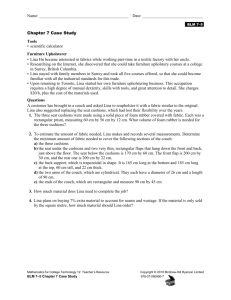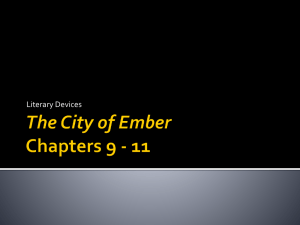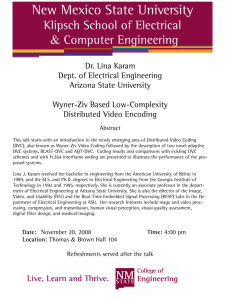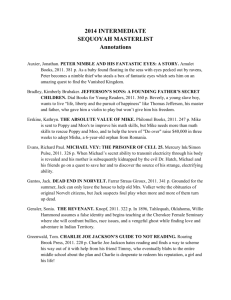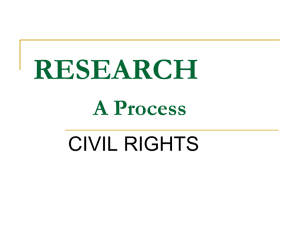File - Laura Holt's Efolio
advertisement
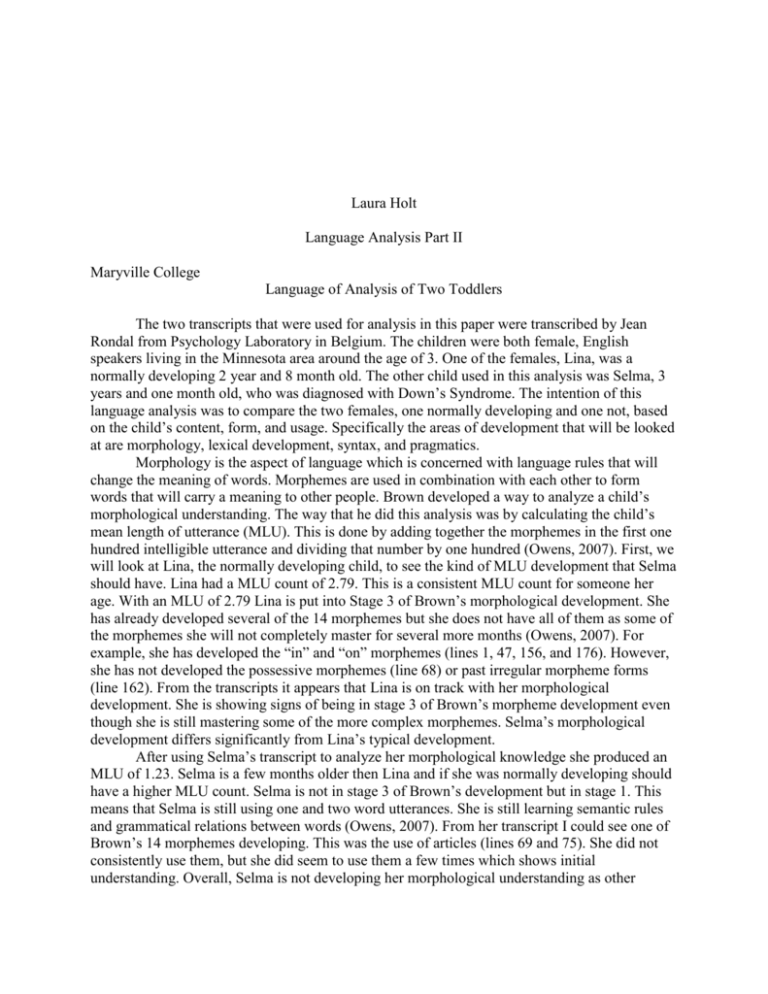
Laura Holt Language Analysis Part II Maryville College Language of Analysis of Two Toddlers The two transcripts that were used for analysis in this paper were transcribed by Jean Rondal from Psychology Laboratory in Belgium. The children were both female, English speakers living in the Minnesota area around the age of 3. One of the females, Lina, was a normally developing 2 year and 8 month old. The other child used in this analysis was Selma, 3 years and one month old, who was diagnosed with Down’s Syndrome. The intention of this language analysis was to compare the two females, one normally developing and one not, based on the child’s content, form, and usage. Specifically the areas of development that will be looked at are morphology, lexical development, syntax, and pragmatics. Morphology is the aspect of language which is concerned with language rules that will change the meaning of words. Morphemes are used in combination with each other to form words that will carry a meaning to other people. Brown developed a way to analyze a child’s morphological understanding. The way that he did this analysis was by calculating the child’s mean length of utterance (MLU). This is done by adding together the morphemes in the first one hundred intelligible utterance and dividing that number by one hundred (Owens, 2007). First, we will look at Lina, the normally developing child, to see the kind of MLU development that Selma should have. Lina had a MLU count of 2.79. This is a consistent MLU count for someone her age. With an MLU of 2.79 Lina is put into Stage 3 of Brown’s morphological development. She has already developed several of the 14 morphemes but she does not have all of them as some of the morphemes she will not completely master for several more months (Owens, 2007). For example, she has developed the “in” and “on” morphemes (lines 1, 47, 156, and 176). However, she has not developed the possessive morphemes (line 68) or past irregular morpheme forms (line 162). From the transcripts it appears that Lina is on track with her morphological development. She is showing signs of being in stage 3 of Brown’s morpheme development even though she is still mastering some of the more complex morphemes. Selma’s morphological development differs significantly from Lina’s typical development. After using Selma’s transcript to analyze her morphological knowledge she produced an MLU of 1.23. Selma is a few months older then Lina and if she was normally developing should have a higher MLU count. Selma is not in stage 3 of Brown’s development but in stage 1. This means that Selma is still using one and two word utterances. She is still learning semantic rules and grammatical relations between words (Owens, 2007). From her transcript I could see one of Brown’s 14 morphemes developing. This was the use of articles (lines 69 and 75). She did not consistently use them, but she did seem to use them a few times which shows initial understanding. Overall, Selma is not developing her morphological understanding as other children her age are. She is not showing the development that Lina is in her transcript for other children her age. One of the reasons this morpheme development may be so different between the two girls is because of the difference in their lexical development. Children are developing their mental lexicon up to about fifty words before the age of eighteen months. After this initial word development children go through a vocabulary growth between the ages of eighteen and twenty-four months old. This vocabulary continues to grow between the ages of 1-7 years when typical children are learning about 860 new words a year (Owens, 2007). Lina’s lexical development illustrates this growing ability. She has already undergone her lexical vocabulary spurt and in just the short amount of time her took her to produce one hundred utterances Lina used one hundred and three different words. Her word usage was very diverse too. She was using several modifiers (lines 16, 20, 21, 47, 49, 76, and 199) just to show a few that she used. Modifiers are something that are not present in early lexical development like other common words are (Owens, 2007). Lina does not seem to be making any under or over extensions in this part of the transcript. However, it cannot be concluded that she never makes these mistakes without looking at the entire transcript. Selma’s lexical development varies drastically from Lina’s. Selma’s vocabulary usage is significantly lower than Lina’s. Selma has shown a delay in language due to her Down Syndrome diagnosis. For the first one hundred utterances Selma produced 53 words. It appears that she is most likely somewhere in-between learning her first fifty words and the lexical growth spurt that is supposed to occur. Her words fall into the grammatical classification of first fifty words somewhat consistently with what other researchers have done (Owens, 2007). The table below will illustrate this. Category General Nominals Modifiers Functional Action Specific Nominals Personal-social # Words 16 13 10 9 4 1 As you can see, Selma produced more functional words then what was expected of her and less personal-social words then she should have. This is probably because she may be just coming out of the first fifty words stage. Also, her disability diagnosis most likely will influence the personal-social words that she uses. Selma is in the one-word utterance stage for the most part as this can be seen along side her lexical development. Since she is in the one-word utterance stage is hard to determine if she is making under or over extensions. A further look into her utterances may allow for these kinds of assumptions to be made just like Lina’s transcript. However, Lina is far beyond this stage. Therefore, the next language topic to be addressed will be syntactic development in these two girls. Syntax is part of the form of language that we use. Syntax refers to the rules that govern word, phrase, and clause order. It also tells the relationship between words and sentences (Owens, 2007). For the analysis of these transcripts the focus will be on the combination of words into sentences and where Lina and Selma fall into the realm of typical developers. Lina since she is almost three years of age should be into three and four word combinations. From her transcript she often exceeds these words combinations using 5-8 words (lines 2, 47, 68, 73, 82, 84, 168, 179, 184, 186, 198, and 238). Lina even produces a twelve word utterance on line 198. For the most part, Lina’s word order is correct as well. Lines 156 and 179 are examples of where she is using word order correctly with the longer utterances. There are a few places where she could be clearer with her would order (lines 1, 2, and 168). Her errors could be classified as leaving out information such as subjects or pronouns. For example, in line 2 she repeats the first two words but does not describe what has a chain for the people. This shows that there is not a clear subject in the utterance. Lina is also asking questions with her extended utterances. On line 222 she cannot remember how old her sister is so she asked her mom the question even though her mom was the one that asked her question first. Lina says, “ how is Christ?”. The intent of this utterance is to know how old Christ is but Lina omitted a word. This question was formed based on the previous statement from the mother. Therefore, Lina was reduplicating the question to find out the answer. Clearly, Lina is fairly developed in her syntactic knowledge. She is learning what words can go together and how to express her meanings with her words. For Selma this is not going to be the same result. Selma should be in the multiword combination stage of her syntactic development by twenty-four months old. However, she is still in the one-word utterance stage at 37 months old. Therefore, she is still using some of the strategies that help her develop syntactic knowledge. One of these is focus operations. A focus operation is when the child picks out specific words to imitate. This kind of selective repetition aids in vocabulary development and Selma’s ability to understand when to use certain words (Owens, 2007). Selma does this constantly throughout the transcript like on lines 2, 5, 10, 68, 78, 93, and 115, however, there are many more lines where she does this. Another syntactic strategy that she uses is protowords. A protoword is a consistent vocalization for specific intentions (Owens, 2007). Selma does this by using Nana to represent her brother Nathan. She is consistent with this as she uses it on lines 556, 560, and 562. Even though Selma is not in the correct stage of syntax development she is using strategies that are consistent with typical children to develop her syntax knowledge. Pragmatics is how the child uses the language that they have to communicate to other people. Pragmatics is developing between the ages of two and five. There are some important skills that are associated with pragmatic development (Owens, 2007). The ones that will be analyzed in Lina and Selma’s transcripts are requests, turn taking, and decontextualized language. Lina makes personal requests which is an important stage in pragmatic development (line 234). She is saying that she wants the “choo choo” but is not directly asking her mother to give her the toy. This shows that she is in a deeper level of pragmatics because she understands what saying “choo choo” is going to get her in return. Turn-taking is the ability of the child to show that they understand the structure of a conversation. This is a socially bound pragmatic device that adds to what you want to communicate. Lina demonstrates throughout the transcript the ability to wait on responses and to respond to communication. There are a few times when it is clear she is ignoring the requested response (lines 236 and 237). Her mother is wanting Lina’s attention but her attention is elsewhere. The last important part of pragmatic development is the idea of decontextualized language. This is also called presupposition. Presupposition is the ability to take another person’s point of view into account. At the beginning of the transcript, I believe Lina is touching on this concept. This is show in lines seven through fourteen. In these lines Lina’s mother is asking Lina who her friends are at school, Lina is then answering her with the names of the children. This could be looked at in two ways. The first way is that Lina is not using presupposition and her mother had no idea who her friends are, however, the other way is that Lina knows that her mom has met those students and she is using that knowledge to answer her mom. From the transcripts, it is not clear which of these two situations is occurring. Since Lina is developing on tract in the other areas of language development this might be showing the first stages of presupposition in her language. It does not seem that Lina fully grasp her mother’s perspective yet, however, she may be close to understanding more about it. These are the ways that Lina is developing her pragmatic development as compared to what is expected of her. Selma, since she is still in the one or some two-word stage, is not going to be as developed in her pragmatic use of language. Selma’s use of language is going to be different then the way that Lina uses language. However, Selma does make requests which is showing pragmatic development (lines 45, 232, 456, and 509). Selma’s requests are different then that of Lina’s in the transcript. Selma uses protest (line 496). This is when the child does not want something or an action to take place in the environment. Selma most likely already used protest gestures before using protest words (Owens, 2007). Another type of request that Selma uses is the calling request. She does this by calling for attention from her mother (line 158). Selma uses a different kind of turn taking then Lina does in this transcript. Selma is not highly vocal, but she does talk at appropriate times. However, when Lina talks she repeats much of what her mother is saying which is not proper conversation. Selma shows no signs of using decontextualized language ability. She may have shown this in different parts of the transcript that are not analyzed here, but there is no way to determine this with the script that is being used in this paper. Therefore, Selma is showing some pragmatic development but it is not as advanced as Lina’s development is. When choosing these two transcripts to analyze, two females of relatively close age, who had the same cultural background were chosen because of their similarities in many of the variables that can affect language. One of the females was a typically developing child while the other girl, Selma, was diagnosed with a disability. The choice of these two transcripts was to determine what kind of relationship existed between cognitive ability and language growth. For the study completed by Rondal the impaired subject had to show a delay in cognitive ability. It can bee seen from the analysis that took place here that this delay carries over into the language ability domain which would most likely be expected. This analysis shows that a great deal of disparities in language exist between a typically developing child and a child diagnosed with Down Syndrome. The developmental delay in children with Down’s Syndrome is something that effects the development of language as well. This may not always be the case, however, it is true for the two females that were analyzed here. I feel that by looking at these specific language categories, mainly form and use, I have been able to add to my understanding of children who are diagnosed with a disability. I have seen the areas that it would be difficult to work with and how this language delay would carry over into the classroom setting. These are the kinds of issues that I will be faced with in the school atmosphere, and this paper has allowed me to see the great disparity that will exist in my classroom. From doing this analysis I have seen where typical children need to be and where some children with a disability may be at. I will be able to use this knowledge to come up with ways to help the children in my class grow in their language ability up to where typical children are at.References Owens, R. E. (2007). Language Development: An Introduction (7th Edition). Boston, MA: Allyn & Bacon. Rondal, J. (1978). Maternal speech to normal and Down’s Syndrome children matched for mean length of utterance. In C. E. Meyers (Ed.), Quality of life in severely and profoundly mentally retarded people: Research foundations for improvement. Washington, DC: American Association on Mental Deficiency.
